Polypropylene – Recycling-plastic – Oil 21-11-2022 - Arhive
Polypropylene – Recycling-plastic – Oil
-PET-Bottles-0,80I.V. – Petrochemicals
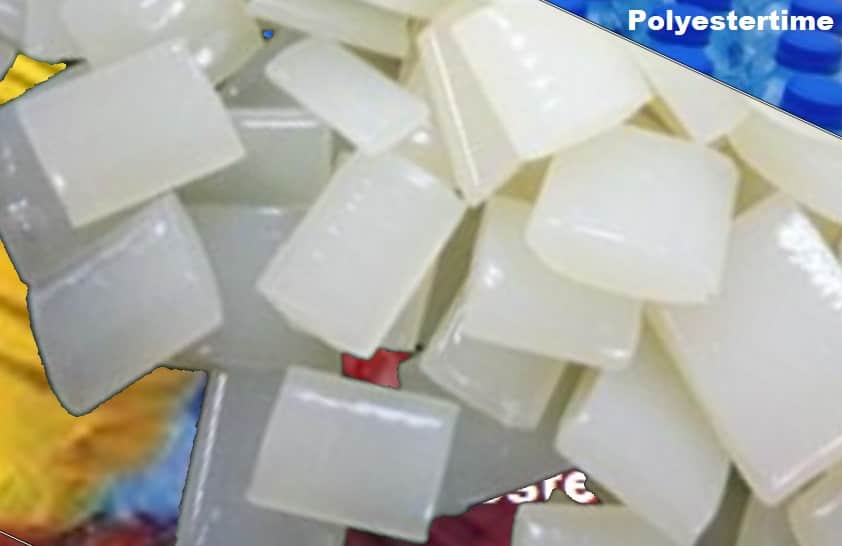
Crude Oil Prices Trend
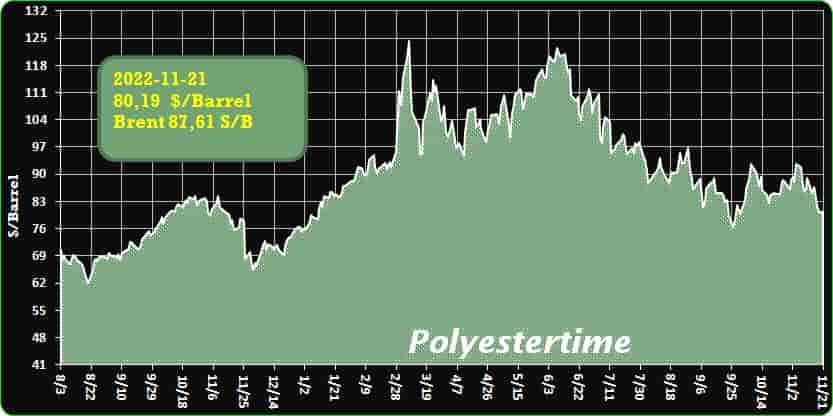
Crude Oil Prices Trend Polyestertime
-Lummus Novolen Technology launches new PPure polypropylene grades
Lummus Technology announced the launch of its Novolen PPure polypropylene (PP) portfolio, a new grade-range of polymers suitable for supporting production of high-quality products for automotive, healthcare components and food packaging materials, said Hydrocabonprocessing.
The new non-phthalate process technology provides significant energy savings by delivering an improved hydrogen response with the catalyst.
“Lummus continues to raise the bar with Novolen’s new line of PPure polypropylene process technologies,” said Romain Lemoine, Chief Business Officer of Polymers and Petrochemicals, Lummus Technology. “The PPure portfolio provides our end users access to new and more sustainable product grades, plus the innovative technology extends the application of an existing plant and reduces CO2 emissions that is unmatched in the current marketplace. We are proud to offer operators a choice in technology based on their need or end-product targets and help our licensees remain competitive in the marketplace.” Polypropylene – Recycling-plastic – Oil
The PPure technology portfolio includes several variants applicable for an operators’ process and end-product requirements. Grades within PPure include high crystallinity homopolymers, ethylene random copolymers and advanced impact copolymers.
The high-crystallinity homopolymers are suitable for injection molding, thermoforming, raffia, cast film and compounding applications. The ethylene random copolymers include high-flow characteristics and ethylene content up to 5 percent, delivering excellent clarity and low extractables, making them a perfect choice for food packaging applications. The advanced impact copolymers convey high flowability and have excellent impact-stiffness balance and no-break behavior, ideal for lightweight interior and under-the-hood automotive parts.
Lummus Novolen Technology GmbH licenses the industry leading Novolen polypropylene technology and provides engineering, technical support and advisory services to the refining industry. The Novolen portfolio includes NPM advanced process controls system, PPConnect digital data analysis platform and Lummus O3S operator training simulator. The Novolen technology includes NEON low volatile extrusion equipment and components, Novolen ComPPact process reactors, which can be used by implementing the proprietary VRC reactor system, allowing for maximum product range and capacity flexibility. Novolen catalysts are available to licensees to produce high-performance and special polypropylene grades and include Novolen CirPPlus recycled polymers, Novolen Enhance performance polymers, PPure polymers and Novocene metallocene catalysts.
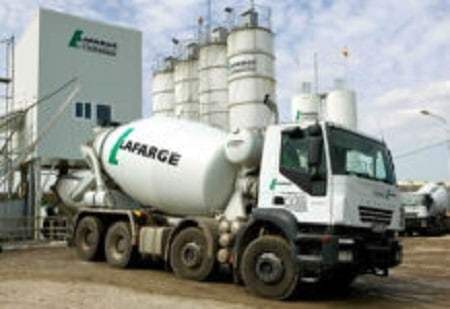
-China ready to take over the world, peace in Ukraine is Xi’s trump card
Xi Jinping’s China emerges victorious from the Indonesian G20 and is a candidate to lead the whole world, granting only a delay to the West before the settlement of accounts that will start from Taiwan and from the control of the South China Sea from which almost all commercial traffic passes planetary. In exchange, it grants the United States and England an anti-Russian position that is closely connected with Taiwan: Russia was wrong to invade another sovereign state by violating the principle according to which no one can snoop in someone else’s house, just like America and the its allies must not poke their noses into the China Sea, including Taiwan.
For a month, Xi Jinping had leaked the news, which we had recorded, according to which Putin at the beginning of February made a serious snub to China by misleading Xi Jinping when the Russian President went to Beijing as the Olympics were ending. Big parties, hugs and group photos, then the Russian went back to Moscow and on the 24th he launched his “special military operation” against Ukraine. The whole world said: “Putin has the full support of China when he went to warn his Chinese counterpart, who evidently gave his consent.” But that wasn’t true. Polypropylene – Recycling-plastic – Oil
Putin had said nothing about his intention to invade Ukraine and Xi Jinping was taken totally by surprise and did not like it at all. But he decided not to make his disappointment public pending the Samarkand summit with all the countries declaredly hostile to the Western world, including Russia, China, India, Pakistan and many others from the former Soviet bloc and the old “third world”.
The summit took place in mid-September but a few days before, a long article by Professor Wang Yiwei, academic and director of Renmin University of China, a close collaborator of Xi and visiting professor at many Western universities, had come out without fanfare. In that long article, which reconstructed the complex and often bloody history of relations between the Soviet Union and China, then settled with a treaty between the Russian Federation and China in 2005, Yiwei recounted that something similar to what Putin had done in 2022 had occurred parties were reversed on July 31, 1958 when Soviet premier Nikita Khrushchev was invited to Beijing for a great celebration of the two homelands of socialism, China and the Soviet Union. Khrushchev left Beijing on August 4 and immediately after Mao Zedong launched the Kinmen Artillery Battle, known in history as the “Second Taiwan Strait Crisis” with heavy shelling of the Quemoi (Kinmen) archipelago occupied by Chang Kai-shek’s army , the nationalist generalissimo who, after having fought together with Mao’s popular army against the Japanese, had been defeated and put to flight by Mao himself and had taken refuge in Formosa.
The Americans – Ike Eisenhower, former commander-in-chief of the allied armies against Nazi Germany was still president – assessed the situation and decided that it would be imprudent to intervene because it was clear that Mao, during Khrushchev’s visit, had obtained their support from the Soviets . When Khrushchev realized the deception – says Wang Yiwei’s article published with the consent of Xi Jinping – he was seized with hysterics and stamped his feet on the ground angrily shouting “That Mao is cunning and arrogant as a rooster from combat!”. The gist of the article was: dear Vladimir, you have matched us and we are patient people who know how to play along, even when the going gets tough. But don’t take us for idiots because your war on Ukraine won’t find our support at all and indeed tell us when you plan to close this regrettable chapter.
The signs of the storm were evident in Samarkand where, despite the enthusiasm of the post-communists of the Western world, very harsh words flew around. Both Xi Jinping and Modi, the Indian president who while partnering with the Chinese and Russians in the meantime carries out military exercises with the Americans, brutally asked Putin when he intended to end his adventure in Ukraine, a source of embarrassment for everyone. Putin replied that the Westerners and America were to blame and Xi Jinping told Putin that he would deal with America himself because relations between the two superpowers were being reviewed because if the Chinese own a large part of American debt (for which Washington pays the annual interest on time), it is equally true that almost all Chinese trade finds its place in America and without the American market China would collapse. In Samarkand probably (nobody said it but one can assume) Putin assured that he had the intention of negotiating, as long as those warmongers in Kiev, starting with Zelensky, stopped inflicting humiliating losses. Polypropylene – Recycling-plastic – Oil
At that point, the American response became extremely flexible towards Xi Jinping because Washington supported with many objective reasons that it had to intervene in support of Ukraine to avoid nuclear proliferation in all non-nuclear countries (especially the former Soviet ones), which the United States wants to avoid at all costs, with which the Chinese are in complete agreement. What is it about?
When Ukraine was declared an independent state in 1992, it returned to Russia all the nuclear weapons scattered on its territory and which belonged to the former Soviet Union. However, he asked as a guarantee of his nuclear disarmament, valid also for the future, that Russia itself, the United States and the United Kingdom guarantee its sovereignty and independence. Putin’s annexationist moves to control Crimea and Donbass alarmed the USA and the UK, but when the February invasion took place, both guarantor countries decided to intervene heavily by supplying the invaded Ukraine with weapons, but with a dropper: Kiev would have received as much was enough to contain the invasion and discourage it, but no more. Why so much caution? The answers came through analyzes filtered by the State Department through Foreign Affairs Think-Tanks and other well-informed analysis centers. The explanation given by the Biden administration to Xi Jinping is this: at least 25 nuclear-armed countries have communicated their intention to proceed with the production or purchase of nuclear weapons to defend themselves in the event of annexation attempts by Russia. Unless, that is the point, Washington and London have not demonstrated by deeds that they have the intention and the ability to defend the attacked Ukraine and that they are ready to do so in the future as well.
The very high costs of supplying the latest generation of computerized weapons to Ukraine have added to the economic crisis and in fact just yesterday Dmitry Medvedev, Putin’s eternal number two, derided that “The Americans have always betrayed their allies and will even the Ukrainians”. Hence the first warnings from Washington which has publicly shown its discontent with the aggressiveness of Volodymir Zelensky and his military circle, warning that the cold months and the slowdown of the war on the ground should have been spent reaching an agreement with Russia, which at this point has to bring home a result, for the negotiation to make sense. Xi Jinping also liked all of this because it allows him to downsize Moscow’s leadership claims and the G20 demonstrated how much his understanding of the American and British position is visible.
But Xi Jinping’s victory immediately translated into an intensification of penetration, espionage and technology acquisition operations both in the United Kingdom and in the United States where both the Mi5 in London and the FBI in Washington were faced with a proliferation of Chinese pressure aiming at the acquisition of political and industrial power in both countries.
Ken McCallum, director of Mi5 raised the alarm at the annual press conference on the banks of the Thames, arguing that Her Majesty’s secret services continually discover traces of continuous: “manipulation of public opinion in favor of China, favoring the careers of senior officials and politicians, i.e. building up debts of gratitude”. And he cited the operation that led to Chinese agent Christine Ching Kyu Lee being unmasked by Mi6 while she was recruiting with royal political figures. Something similar happened in Washington with an FBI operation that captured a cell of recruiters called Fang Fang. McCallum argued that Xi Jinping’s new Communist Party of China has turned into a totally different organism from the one to which the British and Americans were accustomed in the past and that therefore China’s real response on the international theater scene must be seen as a temporary peace destined to buy the necessary time for the final phase of Xi Jinping’s leadership which will consist in the exclusion of the West from the Eastern world and the containment of Russia so that it does not undertake other adventures not authorized by China.
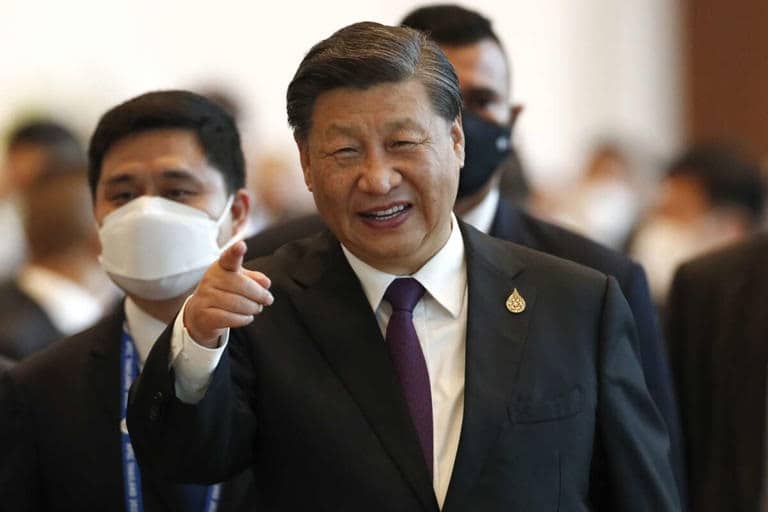
-A tale of two sciences recycling plastic
Two-step approach eliminates the need to sort plastics before they are recycled
Scientists have developed a process for converting mixed plastic waste into two distinct, useful chemicals. Their method uses a combination of chemical and biological techniques to upcycle mixtures of three common plastics. It could offer a way to streamline recycling processes by eliminating the need to first sort the plastics.
Sorting is not required
Currently, mixed plastic waste, such as what goes into household recycling bins, must be sorted by type before it can be recycled. ‘The motivation was to avoid the expensive and quite tedious sorting of mixed plastic waste,’ says Gregg Beckham from the National Renewable Energy Laboratory in Colorado, US, who led this research. The process is also suitable for plastic waste containing different polymers bonded together, such as multilayer packaging and some textiles. Polypropylene – Recycling-plastic – Oil
The three polymers this process is suitable for are:
high-density poly(ethylene) (HDPE), with uses including milk containers and bottles for personal care products poly(ethylene terephthalate) (PET), commonly used for food and drink packaging, especially for single-used beverage bottles poly(styrene), which is widely used as disposable food trays, cups and plates.
These three plastics make up the majority of post-consumer plastic waste.
Chemistry and biology unite
The team’s recycling process has two steps. First, the polymers are oxidised by air with the help of a cobalt–manganese–bromide catalytic system to produce a soup of carboxylic acids. Next, the mixture is fed to soil bacteria for further conversion. The bacteria used are Pseudomonas putida, which naturally consume benzoic acid and dicarboxylic acids (produced by the HDPE and polystyrene breakdown). The team genetically engineered the bacteria to consume terephthalic acid (from PET) as well.
Further genetic engineering produced two distinct bacteria strains that produce two different end products. One converts the carboxylic acid mixture into polyhydroxyalkanoates (PHAs), which are used in biodegradable food packaging and for biomedical applications such as dissolvable sutures. The second strain transforms the soup into β-ketoadipate, which can be used to make performance-enhanced nylons.
‘The study is one of the first to show how to get from a mixed waste stream to a pure product and uses a very interesting interdisciplinary approach,’ says Ina Vollmer, an expert on chemical recycling of plastic waste based at Utrecht University in the Netherlands, who was not involved in this project. Polypropylene – Recycling-plastic – Oil
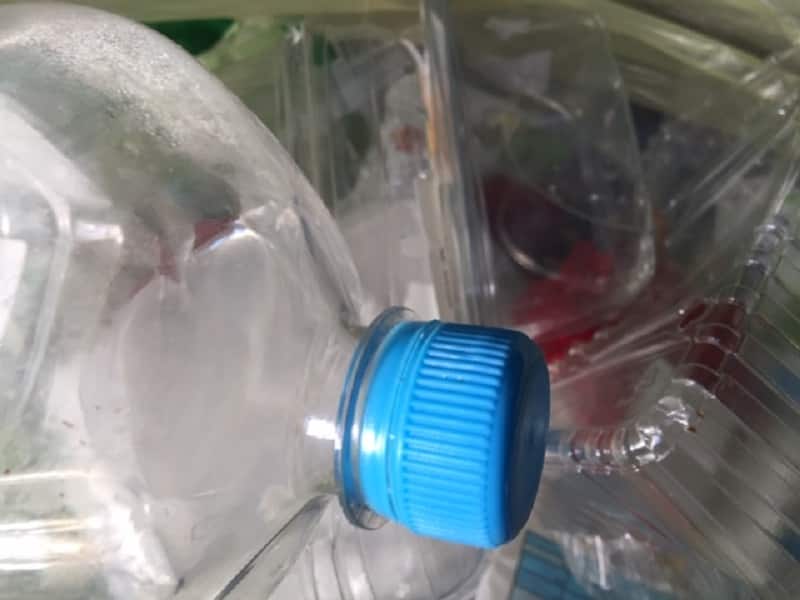
-ExxonMobil, PT Indomobil Prima Energi, Plastic Energy collaborate on chemical recycling initiative in Indonesia
At the G20 Bali Summit earlier this week, ExxonMobil, PT Indomobil Prima Energi (IPE), and chemical recycling pioneer Plastic Energy, signed a memorandum of understanding to assess the potential for large-scale implementation of chemical recycling technology in Indonesia.
Some 100,000 metric tons capacity per year are envisioned, according to the partners. The first phase is projected to be completed in 2025. The companies will also look at improving the plastic waste collection and sorting systems in the country.
PT Indomobil Prima Energi is an Indonesian-based Indomobil Group subsidiary. It operates numerous distributorships, plant facilities, as well as thousands of retail fuel stations. By leveraging IPE’s network and access to local communities, IPE aims to make a difference through the implementation of chemical plastic recycling technology in Indonesia. Polypropylene – Recycling-plastic – Oil
“Indomobil Prima Energi is committed in realising a circular economy to create a better sustainable future,” said Gerry Kertowidjojo, president director of IPE. “This initiative is a collective notion that calls for action and synergy from all stakeholders to play a role as part of a responsible society.”
“Plastics help to raise living standards around the world, including in Indonesia, given their critical use in agriculture, food packaging, medical equipment and more,” said Dave Andrew, vice president of new market development at ExxonMobil.
“Leveraging new technologies and the expertise of our combined organisations, we can accelerate a circular economy for plastics in the region, so that more plastics can be turned into new products instead of ending up in the environment.”
ExxonMobil plans to build approximately 500,000 metric tons of chemical recycling capacity at its integrated manufacturing facilities around the world by year-end 2026, including in the U.S., Canada, Europe and Asia Pacific. At its facility in Baytown, Texas, ExxonMobil has processed more than 6,700 metric tons of plastic waste since startup up in 2021 and is on track to complete large-scale expansion of the facility by the end of this year. ExxonMobil has also signed a memorandum of understanding for chemical recycling in Malaysia and is collaborating with Plastic Energy on an advanced recycling plant in France.
Plastic Energy already has two commercial recycling plants in Spain, which use its patented TAC process to convert plastics into a feedstock called Tacoil, which can then be used to create virgin-quality plastics. Plastic Energy has several plants under construction in Europe, including a 25,000 metric ton capacity plant in France and an offtake collaboration agreement with ExxonMobil, and an MoU for a new advanced recycling project in Malaysia. Polypropylene – Recycling-plastic – Oil
“Indonesia and the Asia Pacific region is an area of the world that is greatly impacted by plastic waste,” said Carlos Monreal, founder and CEO of Plastic Energy.
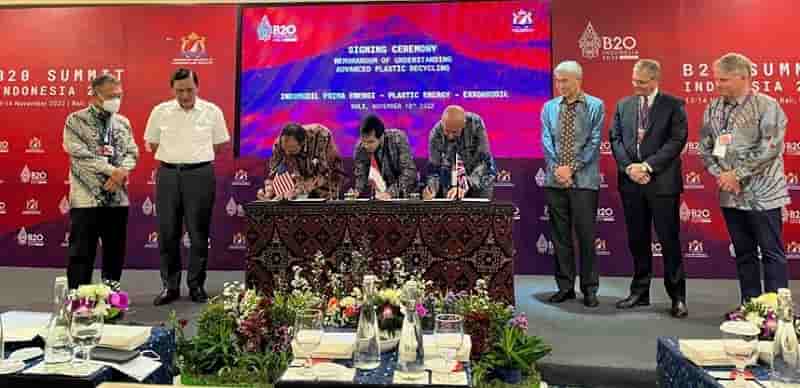
-Compounder Mocom advances bio-EPDM, recycled content TPVs
German manufacturer says up to 90% of CO2 savings possible with new mix of materials
Hamburg, Germany – German compounder Mocom has developed a thermoplastic vulcanisate elastomer (TPV), produced from recycled PP (rPP) as well as, on request, partly bio-based raw materials such as bio-EPDM.
For the range, labelled Alfater XL ECO, the rPP is based on post-industrial-recyclate (PIR), whereas the partly bio-based EPDM has a bio-content of 70%.
According to Mocom, the rPP and bio-based content of the TPV depends on its hardness. So, for example, the rPP content for hard Alfater XL ECO grades (e.g., Shore D50) can be more than 80%, while in soft TPV the bio-based content is respectively high.
“With this mix of raw materials, the production of sustainable TPV materials with different levels of CO2 saving potentials is possible,” the company said.
As an example, if the virgin PP in a peroxide-crosslinked, Shore A60 grade is replaced by rPP, CO2 savings of about 20% are achieved. Polypropylene – Recycling-plastic – Oil
If, in addition, the fossil-based EPDM is replaced by bio-EPDM (70% bio-based content), CO2 savings of more than 50% can be achieved, Mocom’s analyses also shows.
And if the mineral oil is replaced by a bio-based oil, CO2 savings of more than 90% can be achieved, the compounder further noted.
The new Alfater grades, continued Mocom, can be used in typical TPV processes, including injection moulding, extrusion, and press blow moulding.
The ECO TPV materials are also suitable for 2K moulding and are said to exhibit “excellent adhesion” to polyolefins, such as PE and PP, and to thermoplastic elastomers.
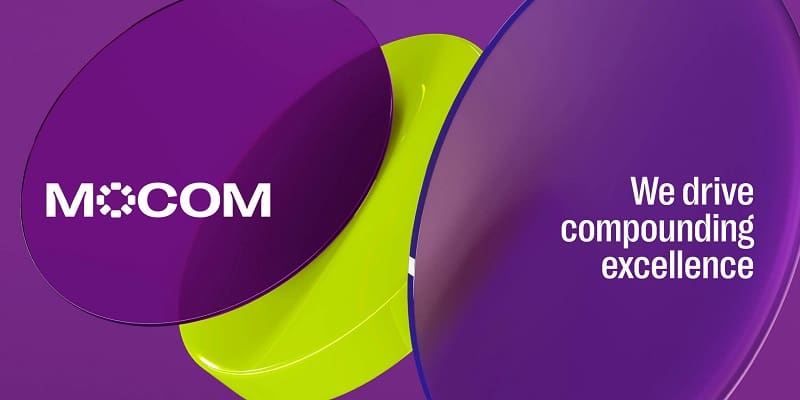
-US oil prices fall 10% in the week as demand worries rise
Weakening fuel demand in China outweighs concerns that Russian supply could drop
Oil prices fell sharply in the week as mounting concerns about weakening fuel demand in China outweighed fears that Russian supply could drop next month when tighter EU sanctions on its crude exports come into force.
West Texas Intermediate, the US benchmark, lost about 10 per cent this week, falling 1.9 per cent on Friday to settle at $80.08 a barrel. It was the biggest weekly loss since March.
US oil prices fell by more than 4 per cent to $78.50 a barrel earlier in the day, to what was the lowest price since September. The WTI futures curve also switched into mild contango — a market structure in which the forward price of a contract is more expensive than the spot price, and which reflects perceptions of oversupply.
Brent crude, the international marker, fell about 9 per cent in the week, losing 2.4 per cent on Friday to settle at $87.62.
Friday’s sell-off left US oil prices down about 14 per cent below the highs struck in October after the Opec+ cartel defied US pressure to announce a plan to cut production in a bid to prop up a weakening crude market. Polypropylene – Recycling-plastic – Oil
Earlier this week, the International Energy Agency trimmed its forecast for global oil consumption growth next year, citing a “myriad of headwinds” for demand, including “rising recession odds, China’s persistently weak economy, Europe’s energy crisis” and the strengthening dollar.
Please use the sharing tools found via the share button at the top or side of articles. Copying articles to share with others is a breach of FT.com T&Cs and Copyright Policy. Email licensing@ft.com to buy additional rights. Subscribers may share up to 10 or 20 articles per month using the gift article service. More information can be found at https://www.ft.com/tour.
In equities, US stocks fell in the week as investors balanced data showing an easing in inflation in the world’s biggest economy against hawkish warnings from the Federal Reserve.
Wall Street’s benchmark S&P 500 fell 1.2 per cent across the five sessions, but gained 0.5 per cent on Friday. The tech-heavy Nasdaq Composite lost 1.6 per cent in the week, and was flat on Friday.
Investors were cautious after a warning on Thursday from James Bullard, president of the St Louis Fed, that previous interest rate rises had “only a limited effect on observed inflation”. The central bank’s main policy rate could increase to between 5 per cent and 5.25 per cent at least, Bullard said, above the level priced in by markets.
The market consensus remains that the Fed will raise rates by 0.5 percentage points when it next meets in December, which would end a run of four consecutive 0.75 percentage-point increases.
Bullard’s comments sparked a slight sell-off in US government bonds, with the two-year Treasury yield, which is particularly sensitive to interest rate expectations, adding a further 0.08 percentage points on Friday to 4.53 per cent. The benchmark 10-year Treasury yield rose 0.06 percentage points to 3.83 per cent as the price of the security fell.
The dollar index, which tracks the currency against a basket of six of its peers, added 0.3 per cent, although it has fallen more than 4 per cent in November.
Jim Paulsen, chief investment strategist at The Leuthold Group, a research company, said a combination of the delayed effect of contractionary monetary and fiscal policies, the dollar’s strength and the growing gap between the yields on two-year and 10-year Treasuries was set to “significantly slow” real economic growth in the US.
“By the first quarter of next year, our guess is that the primary consensus concern will be recession rather than inflation,” Paulsen said. Polypropylene – Recycling-plastic – Oil
Elsewhere in equity markets, Europe’s Stoxx 600 added 1.2 per cent and London’s FTSE rose 0.5 per cent.
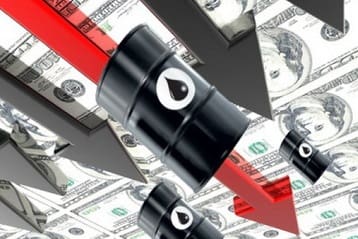
Polypropylene – Recycling-plastic – Oil
